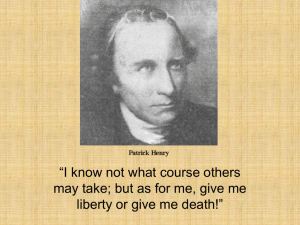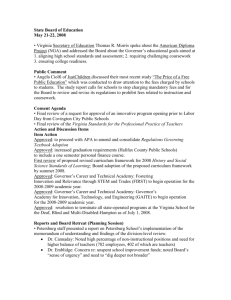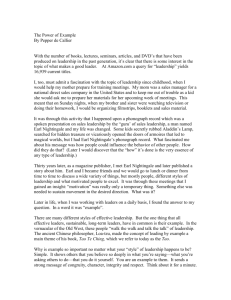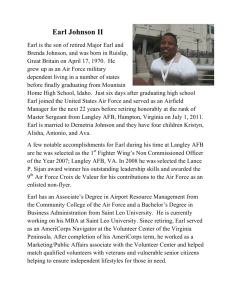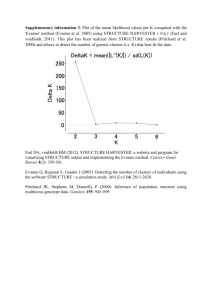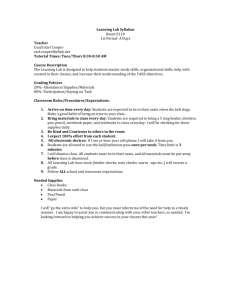The Near Execution of Earl Washington Jr.
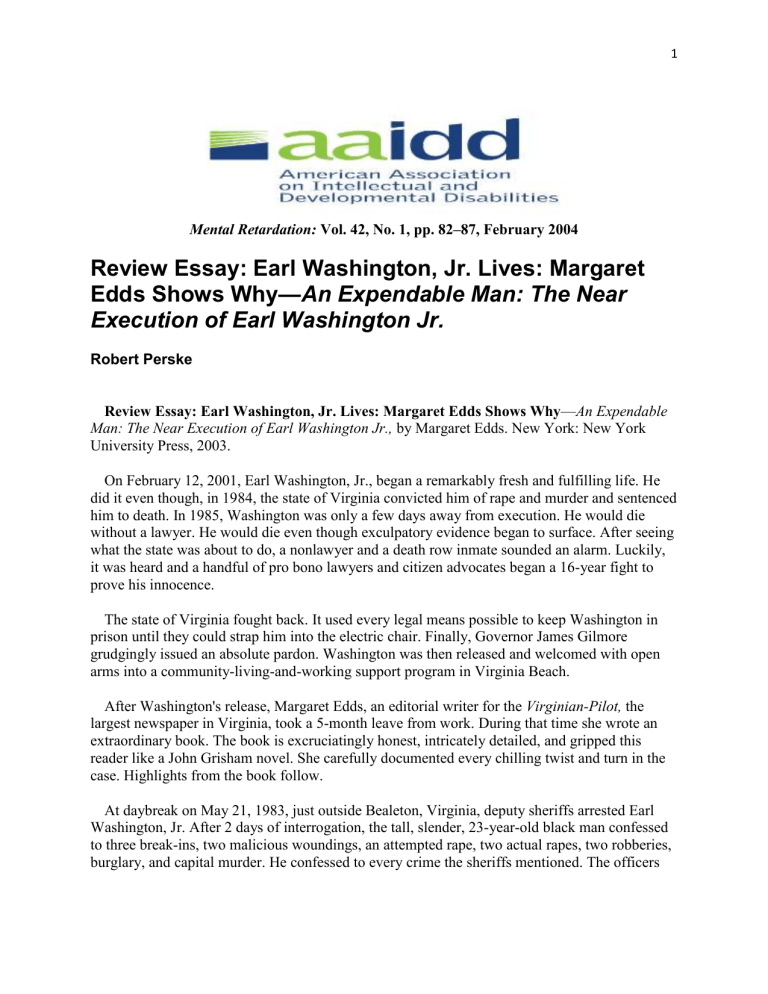
1
Mental Retardation: Vol. 42, No. 1, pp. 82–87, February 2004
Review Essay: Earl Washington, Jr. Lives: Margaret
Edds Shows Why —An Expendable Man: The Near
Execution of Earl Washington Jr.
Robert Perske
Review Essay: Earl Washington, Jr. Lives: Margaret Edds Shows Why — An Expendable
Man: The Near Execution of Earl Washington Jr., by Margaret Edds. New York: New York
University Press, 2003.
On February 12, 2001, Earl Washington, Jr., began a remarkably fresh and fulfilling life. He did it even though, in 1984, the state of Virginia convicted him of rape and murder and sentenced him to death. In 1985, Washington was only a few days away from execution. He would die without a lawyer. He would die even though exculpatory evidence began to surface. After seeing what the state was about to do, a nonlawyer and a death row inmate sounded an alarm. Luckily, it was heard and a handful of pro bono lawyers and citizen advocates began a 16-year fight to prove his innocence.
The state of Virginia fought back. It used every legal means possible to keep Washington in prison until they could strap him into the electric chair. Finally, Governor James Gilmore grudgingly issued an absolute pardon. Washington was then released and welcomed with open arms into a community-living-and-working support program in Virginia Beach.
After Washington's release, Margaret Edds, an editorial writer for the Virginian-Pilot, the largest newspaper in Virginia, took a 5-month leave from work. During that time she wrote an extraordinary book. The book is excruciatingly honest, intricately detailed, and gripped this reader like a John Grisham novel. She carefully documented every chilling twist and turn in the case. Highlights from the book follow.
At daybreak on May 21, 1983, just outside Bealeton, Virginia, deputy sheriffs arrested Earl
Washington, Jr. After 2 days of interrogation, the tall, slender, 23-year-old black man confessed to three break-ins, two malicious woundings, an attempted rape, two actual rapes, two robberies, burglary, and capital murder. He confessed to every crime the sheriffs mentioned. The officers
focused mostly on the worst crime, the rape and murder of Rebecca Williams. It had taken place
11 months earlier in Culpeper, 16 miles southwest of Bealeton.
2
The trial took place 8 months after his arrest. It lasted 3 days, ending with a death sentence.
Shortly after that the Virginia Supreme Court and the United States Supreme Court upheld the conviction. Washington was scheduled to die on September 5, 1985, just 21 months after his sentence.
As the execution approached, two people went into righteous panics over Washington's quick move down the chute toward death. Death row inmate Joe Giarratano wrote a “pro se” (without a lawyer) petition on behalf of Washington. Citizen advocate Marie Deans, the only worker in a shoestring operation, the Virginia Coalition of Jails and Prisons, began “pestering the hell” out of every lawyer she knew who might be of help. The commotion they raised reached members of the New York law firm Paul, Weiss, Rifkind, Wharton, and Garrison. It sent Marty Geer, a young attorney, to investigate.
The first time she faced Joe Giarratano, there was no “hello.” Instead he said, “Earl
Washington has an IQ of 69, an execution date three weeks away and no lawyer. What the hell are you going to do about it?” (p. 83). Giarratano described Washington's trusting compliance with others:
I don't think he had a clue what was happening. If I said it was okay then that was okay with him. If a guard would have said, “Earl, see that chair over there? Do us a favor. Go sit in it. We'll be there in a minute to strap you in.” Earl would have said, “Okay, and went to sit in the chair and wait. (p. 82)
Weekend Brawl
Washington lived in a family known by other locals as “the poorest of the poor,” a whole group of people living in a single dilapidated house. As a poor farm laborer, Washington was a well-liked hard worker. Even so, he took part in the family's weekend recreation—the heavy drinking of cheap liquor and the brawls that followed. On the fateful weekend of May 20 and 21,
1983,
Earl Washington, Jr. had been drinking hard liquor for hours.… As usual, a crowd had gathered for a party.… At first, the party had been friendly enough, but the hours of drinking had turned the evening sour. There were taunts, followed by shoves. Earl Jr.'s fury mounted. Pushing through the crowd, he bolted out the door and headed into the night. (pp. 29–30)
He remembered a pistol on the refrigerator of Hazel Weeks, a white 78-year-old neighbor. Still crazy drunk, he went to get it. At 3:00 a.m. he broke a window in order to open Weeks' kitchen door. Weeks woke up, saw a man, and shouted for him to get out. Washington took a chair and hit her on head. He did it more than once. Bleeding, but still conscious, Weeks told the man to take her money so he would leave. Washington left with the pistol and the money.
When the police arrived at the Weeks home, they heard a gunshot across the road. Rushing to the scene, an officer found Washington's brother, Robert, nursing a gunshot wound in the foot.
According to later reports, the shooting was erratic and accidental. Suddenly, officers heard the pop of a gun back on Weeks' side of the road. They crossed the road, discovered Washington, and took him into custody.
3
Confessions
After Washington sobered up, he confessed to hurting Hazel Weeks. He also voiced remorse for what he did to her. He never recanted that admission and sorrow. When officers asked him about other unsolved crimes in the area, he said “yes” to every one. Finally, an officer asked,
“Earl, did you kill that girl in Culpeper?” Again, Washington said, “Yes.” After that, officers asked short, simple questions about the rape and murder of Rebecca Williams.
Washington gave short answers. The questions and answers were jotted down on paper. No audio- or videotaping was used. No qualified stenographer was present to provide a stenographic record. All 12 pages of the hand-written confession were read into the trial transcript. A few excerpts follow:
Officer : Do you realize you're about to be questioned about a crime?
Washington : Yes.
Have you been advised of your rights?
Yes, sir.
Have those rights been read to you?
Yes, sir.
Do you wish to talk about the stabbing and rape of Rebecca Williams?
Yes. . .
Last June did you go to Culpeper?
Yes.
Who did you go with?
A friend named Billy.
Who else was along?
I don't know him…
Whose car was it?
The boy Billy and I were riding with. [Billy and the driver were never identified]…
Where did you go in Culpeper?
Rode around for awhile.
Where did you go after that?
Went to a set of apartments.. .
Can you show us where these apartments are?
I think I can. [Later, officers drove Washington to the apartment complex; he did not identify the right apartment. Even so, the officers admitted to returning more than once to Williams' apartment. Finally, they returned a third time. An officer said, “Earl, isn't that the place?” He said, “Yes”]…
How did you enter the apartment?
4
Kicked the door open. [There was no evidence of a forced entry.]
Was anybody inside?
A white woman. [Earlier evidence shows that he first said it was a black woman, but he was corrected. Also Washington failed to mention that Williams' daughters, 11-month-old Misty and
2-year-old Mindy, were in the apartment, too.]
What happened then?
I took out my knife.
What kind of knife was it?
A pocket knife that I carried on my side in a case. [The so-called murder knife, a folding pocket knife, was never identified.]
What did you do then?
I stuck her.
Did you stick her more than one time?
One time in the stomach.. .
Did you remove any of her clothes?
Yes, sir.
What clothing?
The halter top [There was no halter top. Washington probably wouldn't have used such a word.]
Did you stab her after you had sex?
Yes, sir.
How many times?
Once or twice. [Williams was stabbed 38 times.]
While you were stabbing her, did you injure or cut yourself?
Yes.
Where?
In my left hand. [There was no evidence that he cut himself.]
Where was Williams when you left the apartment?
I left her in the bedroom on her back… [Williams was found lying across the threshold in the open front door.]
Have you been made any promises for your cooperation?
No, sir.
Have you been threatened in any way?
No, sir.
Are you making this statement of your own free will?
Yes, sir.
Is there anything else you want to say, Mr. Washington?
5
No, sir. (pp. 53–58)
To this day, many Virginia officials feel the confession was valid. No physical evidence ever connected the defendant to the crime.
6
Ineffective Defense Lawyer
Prosecutor John Bennett's opening statement filled 11 transcript pages; Defender John Scott's opening only required 3. Bennett called 14 witnesses, requiring 162 pages for testimony and cross-examination. Scott only called 2 witnesses, Washington and his sister Alfreda for a total of
27 pages.
Bennett's closing statement covered 9 pages. Scott's only consisted of 15 sentences. Scott failed to do battle over many points Bennett raised. He believed a jury would automatically see all of the reasonable doubts in this case. They did not.
Putting Washington on the stand was fatal. Prosecutor Bennett made mincemeat of him. His fumbling yes-and-no answers were no match for the smooth-talking officers who gave their version of what went on during those long hours of interrogation.
Because the confession was all that the prosecutor had to go on, a skilled death penalty defender would have moved into that signed statement like a brain surgeon. Defender Scott did not. He had never handled a capital case. He was also disadvantaged because the judge's two appointed lawyers resigned right after the preliminary hearing. Consequently, Washington's family pooled meager resources. They found Scott. He took the case for little more than nothing.
Later, he openly admitted that he did not know what he was doing.
Slowing the Machinery of Death
After Marie Deans and Joe Giarratano confronted Geer, things started moving. Eric Freedman, who was an attorney with Paul, Weiss and later a law professor at Hofstra, jumped into the fray.
The timetable was tight. They had to build a habeas petition from scratch. It had to be delivered to Judge Lloyd Sullenberger's chambers in Culpeper on a Tuesday at 4:00 p.m., just 9 days before the execution. The last weekend was harrowing:
On Friday, several other associates agreed to devote their weekend to helping out. A larger team had become essential. At about 2:00 a.m. that night, Geer thought she saw a law firm partner running down the hall and, as a joke, jumping on the back of a major client. Thinking that she must be hallucinating from a lack of sleep, she went home. She returned at 10 a.m.
Saturday and worked until 9:00 p.m. Monday with one hour of sleep on an office couch. Eric too had been working almost nonstop, taking only forty-five minute naps most of the week. (p. 50)
They made the deadline, and Judge Sullenberger quickly issued a stay of the execution. Later, however, he dismissed the petition. Even so, the delay was helpful. It enabled lawyers Bob Hall,
Eric Freedman, Barry Weinstein, Jerry Zirken, and nonlawyer Marie Deans to solidify and take over the case.
7
Startling Discoveries
As Hall dug deeply into the case, he discovered 84 items of forensic evidence, ranging from cigarette butts, fingernail scrapings, blood samples, pubic hair samples, finger prints, and palm prints. He also discovered material taken from vaginal swabs and a blue blanket with seminal stains on it. Neither side introduced any of it as evidence during the trial!
Hall even discovered certain blood samples connected with the perpetrator that did not match with Washington. Henry Lee, the nationally famous forensic expert, went on record stating that this was true—but nothing came of it.
The defense continued to press. Finally, the state agreed to do last minute DNA testing on the vaginal swabs. The results showed that Washington “more than likely” was excluded due to a
“1.1. allele” that belonged to neither him, the victim, or the victim's husband. Even so, the state threw a strange curve, arguing that a second rapist could have confounded the results. The courts upheld this argument—even though the victim in her dying words claimed that a single black man raped her.
Futile Appeals
After the first stay, all of the state and federal appeals that followed contained exculpatory evidence. Even so, they were dismissed for the following reasons.
1.
The 21-Day Rule.
In Virginia, new evidence—even evidence of innocence—cannot be introduced more than 21 days after the trial court sentence is certified.
2.
The Rule of Procedural Default.
Except in rare cases, this rule bars criminal defense attorneys from raising an issue on appeal that was not brought up during the original trial.
3.
A Finding That the Trial Lawyer Was Effective.
Considering the two previous barriers, all that the defense lawyers could argue was that the trial lawyer was inept.
Scott cooperated. He openly admitted that he was ineffective. Even so, all judges ruled that the trial attorney’s strategy was valid. The five defense tigers were crushed. It began to look as if no court would ever call for a release or retrial.
A Governor's Deal
Governor Douglas Wilder refused to touch the Washington case as long it was “in the courts.”
Also, his term as governor was almost over.
Members of the defense team suddenly made a hair-raising decision. They announced that they would no longer appeal on Washington's behalf. Instead, they asked the governor for a pardon before leaving office.
8
The governor did not like being put on the spot like that. He became angry. The state's attorneys became angry. The team waited.
Governor Wilder suddenly received 260 letters from public officials. They came from the Arc of Virginia, The Arc of the U.S. (formerly known as the Association for Retarded Citizens), other advocacy groups—even from the British House of Commons. Finally, Wilder ordered that the seminal stains on the blue blanket be tested for DNA. He further ordered that the test results be given to him on the morning of July 14, 1994, his last day in office.
The last day came. The defense team waited to receive the report on the blanket. It did not come. Then, at 3 p.m. on that last day before his leaving, Wilder offered a deal. He would grant a
“conditional pardon only.” He would commute the death sentence to life in prison.
Washington had to accept or reject it by 5 p.m. Marie Deans and Barry Weinstein rushed over the 99 miles between Richmond and the Mecklenburg prison. Bob Hall waited in his office, ready to call the governor's office as soon as he heard from Weinstein and Deans.
Washington was forced quickly to make a terrible choice. If he accepted life in prison, he might never get out. If he rejected it, he could be executed as early as March.
Washington accepted life in prison. Marie Deans cried. Washington took her hand. “I'll be all right,” he said.
Deans and Weinstein quickly called Hall in Richmond. It was almost 5 p.m. Hall called the governor's counsel, Walter McFarlane. There was no answer. Hall talked to a capital guard and asked him to find McFarlane. He said it was a life or death matter. McFarlane called back:
“You've got a deal,” Hall told him.
“Your time came and went,” McFarlane responded.
“You could have called us earlier,” Hall said. (p. 156)
Bob Hall was not one to show anger, but there was no mistaking his outrage now. “You advise the governor,” Hall said, “that once we determine which [inaugural] ball he's attending tonight, we'll be having a press conference outside and I have reason to believe it will be well attended by the press.”
Within a half-hour, the governor accepted Washington's decision. Sadly, he languished in prison for the next 5 and a half years.
The Blue Blanket
On November 28, 1994, Bob Hall wrote to McFarlane, Wilder's former legal counsel and now the head of the Virginia Department of Corrections. Since the defense team never received a report on the testing done on the blue blanket, he asked for a report. Hall wrote:
9
We are given to believe that the testing of the seminal fluid stains on the royal blue blanket further exonerated Earl from any responsibility in this crime and disclosed some of the DNA genetic information identifying the actual killer or, at a minimum, it genetically identified persons other than her husband with whom she may have had sexual relations. (p. 161)
Hall urged McFarlane to contact Dr. Paul Ferrara at the state laboratory and approve the release of the results. McFarlane did not reply nor was any answer required under the Virginia system.
A Frontline Surprise
Ofra Bikel, a producer for PBS Frontline, began gathering data for a film on prisoners who might be innocent. Because Washington was one of them, she visited with Dr. Paul Ferrara, director of the Virginia Division of Forensic Science. During her conversation, she casually asked about the report to the governor regarding seminal stains on the blue blanket. Dr. Ferrara got her a copy. She immediately saw that the report stated “Earl Washington, Jr. is eliminated as the donor of the HLADQa types obtained from blue blanket, stains A, B and C.” She felt an inward surge of excitement. Washington had been eliminated, but she continued to sound nonchalant about it all.
Bikel kept the information quiet until she interviewed Bob Hall, former Attorney General
Stephen Rosenthal, and former Governor Wilder for Frontline's “A Case for Innocence.” When it aired on January 11, 2000, the three interviews were presented, one after the other.
During his interview Bob Hall said that he wished he had the report on the blue blanket that was sent to Wilder on the morning of his last day in office.
Ofra Bikel : Do you want to know?
Bob Hall : I'd like to know.
Ofra Bikel : We found out.
Bob Hall : Well I hope you will share it with me.
Ofra Bikel : The blanket excluded him. (p. 169)
She handed him the document and waited as he read it. After he read it, Hall remained calm, but viewers could see he was seething inside. The documentary then switched to an interview with former Attorney General Rosenthal, who was handed the report:
10
Stephen Rosenthal : This is the first time I've seen this document.
Ofra Bikel : Now should the governor's office have known?
Stephen Rosenthal : Well, obviously. That's something you need to take up with the governor,
I—I—this is the first time I've seen this document. (p. 170)
As the interviews continued, it became clear that former governor Wilder knew about the report. Then came his interview, and he was handed the report. He was told that the defense never received it:
Douglas Wilder : They sent the results of that DNA test and you're saying no one knew the results?
Ofra Bikel : No one.
Douglas Wilder : I didn't know that.
Ofra Bikel : No one.
Douglas Wilder : Well, I didn't know it. (p. 170)
The report enabled the defense team to engage in pitched battles with the state again. The state did not suddenly throw in the towel. Governor James Gilmore had been a hard-on-crime candidate. He did not take kindly to all the pressure being put on him; but he finally ordered more DNA tests. When the test results were announced, Washington was again excluded as the rapist.
The governor then stated that if Washington were released, there would be no place for him to go. The team immediately contacted Dr. Ruth Luckasson, president of the American Association on Mental Retardation, asking for help. Luckasson knew the case well because she served as one of the first solid evaluators for the defense. She searched and found Kay Mirick, the director of
Support Services of Virginia.
Luckasson and Mirick conferred. Then Mirick developed a thorough, on paper, community support system plan for Washington. [Washington was involved in the planning decisions.] His home would be in Virginia Beach. Mirick's agency stood ready to receive him as soon as he was released.
Finally, on October 2, 2000, Governor Gilmore issued an “absolute pardon.” He did not issue an apology. He only said he believed a jury currently hearing evidence in the case would not convict Washington.
11
Glorious Freedom and Fresh Support
Washington was released on February 12, 2001, a year and a month after the Frontline show.
[Probation technicalities from the Weeks affair caused the delay.] He was driven directly to
Virginia Beach, where Kay Mirick and the people of Support Services Inc. welcomed him with open arms:
Awaiting him were a home, a job, and a community of people ready to meet him halfway in creating relationships and a productive life. He rose to the challenge, performing well as a handyman and work partner of Mark Carpenter, learning to negotiate many of the tasks and skills necessary for independent living….
He was not completely independent, however. He could not manage a checkbook, so Support
Services Inc. functioned as a bank, doling out allowances and overseeing bill payments.… Can
Earl open a bank account by himself? “Probably not,” said attorney Weinstein. Can Earl rent an apartment by himself? “Probably not.” But could he live a useful life in a setting designed to capitalize on his strengths and weaknesses? Yes. (p. 208)
The arrangement and the new relationships are working well. On May 4, 2002, Earl
Washington, Jr., and Pamela Marie Edwards, also a client of Support Services Inc., were married. The book contains a touching wedding picture with Washington in his white tuxedo and his four lawyers standing up with him. Margaret Edds ends her book with warm vignettes about the togetherness of Earl and Pam—making it obvious that they deeply love each other.
For better than 18 years, the state of Virginia assumed that Washington was worthless and deserving of death. Many state officials still feel that way, but Edds closes her book, arguing for the opposite: “Sitting in that normal place on an average day, with his wife across the table, it was easy to recognize in Earl Washington the worth that was there, visible to anyone inclined to see” (p. 212).
Reference
Bikel, O. (Writer & Producer). (2000, January 11). The case for innocence. Frontline.
Author: Robert Perske, Citizen Advocate and Writer
E-mail: Rperske@aol.com
, Website: www.robertperske@aol.com
.
© Copyright by American Association on Mental Retardation 2004
